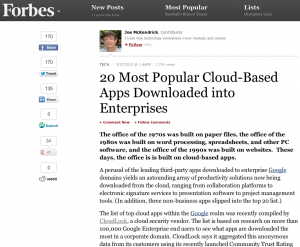 One of the best tools we have at CloudLock is an audit report. It’s simple: we run our app on a customer’s domain, and produce a report with a security score, showing them which 3rd party apps are installed in their Google Apps domain. We’ve found it to be much more effective than simply giving them access to a free trial. (I’ll create a post on this later).
One of the best tools we have at CloudLock is an audit report. It’s simple: we run our app on a customer’s domain, and produce a report with a security score, showing them which 3rd party apps are installed in their Google Apps domain. We’ve found it to be much more effective than simply giving them access to a free trial. (I’ll create a post on this later).
About 2 weeks ago, I had a thought: We’ve done audits for companies representing hundreds of thousands of end-users. Why not go through the audit data to see what we find? Maybe we could even get some good coverage.
Journalists Love Numbers
If you were a writer for a top publication, what would you rather have?
- A story about an obscure new feature in an app
- An advertorial-style puff piece from a company
- Real data that proves a theory, and results in analysis of a new industry trend that hasn’t been covered
3, right?
There’s a constant stream of new feature pitches that every writer deletes. Unless you’re Google or Apple, a new feature isn’t likely to be interesting enough to cover. But if you’re able to provide real, no bullshit numbers and an analysis that supports a point of view….well then you have something.
Have A Story
But don’t just stop at the numbers. Having numbers without a story is the same as a story without proof: it’s a start, but not interesting enough. Our story starts with a simple point of view:
Google Apps provides an opportunity for enterprises to transform the way they deliver IT. The platform extensibility and rich ecosystem of 3rd party applications allow employees to work the way they live. Enterprises can accelerate and multiply the ROI of Google Apps by allowing their employees to adopt the web and mobile apps that make them most productive.
In other words:
When companies give employees the tools they want to do their jobs, they’ll be more efficient. When companies move to Google Apps, they’re allowing employees to use any number of 3rd party apps to accomplish their tasks. Deny them those tools, and they’ll find a workaround. They’ll use personal accounts and unsanctioned apps, therefore taking control of company data out of the hands of IT.
We parsed the data of over 109,000 employees, and looked at the top applications installed in enterprises using Google Apps. What did we find? The top 20 apps are used to get work done.
The Result
20 Most Popular Cloud-Based Apps Downloaded into Enterprises – Forbes
From the article:
A perusal of the leading third-party apps downloaded to enterprise Google domains yields an astounding array of productivity solutions now being downloaded from the cloud, ranging from collaboration platforms to electronic signature services to presentation software to project management tools. (In addition, three non-business apps slipped into the top 20 list.)
The list of top cloud apps within the Google realm was recently compiled by CloudLock, a cloud security vendor. The list is based on research on more than 100,000 Google Enterprise end users to see what apps are downloaded the most in a corporate domain. CloudLock says it aggregated this anonymous data from its customers using its recently launched Community Trust Rating platform. Most of the apps are accessed via Gmail, GDrive files, Google Docs, or Google Contacts.
The Takeaway
You won’t always have huge, newsworthy announcements that the media will jump at. But if you get creative and have a point of view, it’s amazing what you can do.
